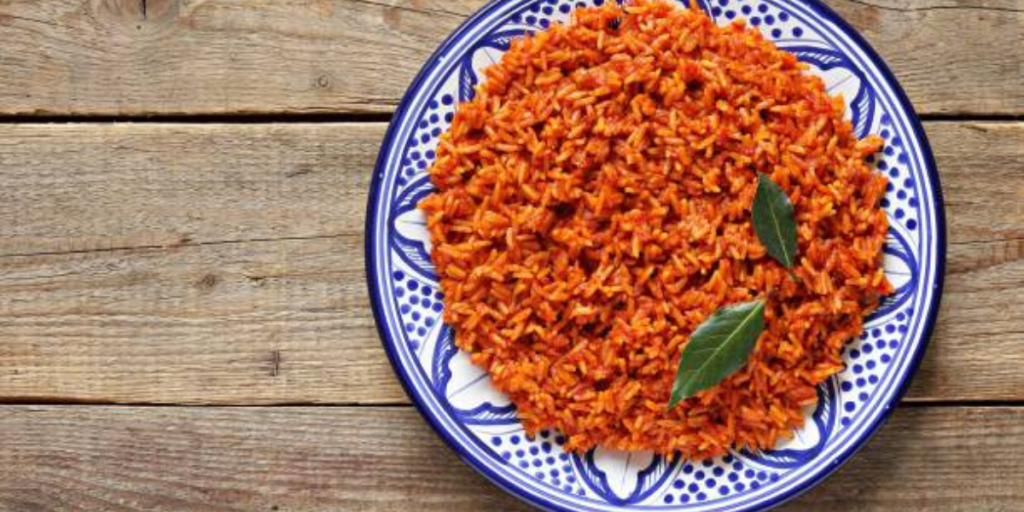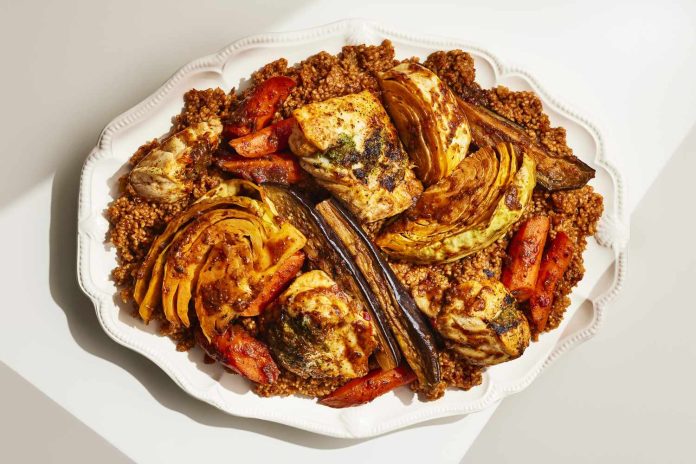Table of Contents
Senegalese Jollof rice ,Thieboudienne (also known as Ceebu Jen in Wolof or Thiebou Dieune in French) is not just a dish; it represents the culinary soul of Senegal. Renowned as Senegalese Jollof Rice, this beloved meal is steeped in tradition, flavor, and history. With its perfect combination of broken jasmine rice, marinated fish, and a colorful array of vegetables, Thieboudienne exemplifies the rich flavors and cultural heritage of Senegalese cuisine.
The Cultural Significance of Thieboudienne( Jollof Rice senegal)
Thieboudienne is more than just food; it embodies the values of community and family in Senegal. In Senegalese culture, food plays a central role in social gatherings and celebrations. When preparing Thieboudienne, families often come together to share the cooking process, which can turn into a festive event filled with laughter, stories, and bonding. This communal aspect of dining emphasizes the Senegalese philosophy of “teranga,” meaning hospitality, where sharing food symbolizes friendship and welcome.
Traditionally served in a large communal bowl, Thieboudienne is a centerpiece during important occasions such as weddings, naming ceremonies, and religious festivals. It symbolizes abundance and togetherness, reflecting the Senegalese value of community. In many households, the preparation of this dish is a labor of love that involves multiple family members, each contributing their skills and knowledge.
The History and Evolution of Senegal Jollof Rice

A Dish with Deep Historical Roots
The origins of Senegal Jollof Rice can be traced back to the Wolof Empire, which flourished in West Africa between the 14th and 16th centuries. The Wolof people were instrumental in trade and agriculture, and they spread the concept of Jollof rice across the region. This foundational history is crucial in understanding how Thieboudienne evolved over centuries, becoming a beloved national dish.
The Role of French Colonial Influence
The introduction of broken rice into Senegalese cuisine can be attributed to French colonial practices in the 19th century. During this time, the French imported significant quantities of low-quality rice from Vietnam and other regions. This broken rice, initially viewed as inferior, quickly gained popularity among Senegalese people due to its affordability and versatility. Over time, broken rice became a staple in Senegal, forming the basis of Thieboudienne and other local dishes.
Penda Mbaye and the Invention of Thieboudienne
The story of Penda Mbaye, a talented cook from St. Louis, Senegal, is vital to the history of Thieboudienne. Oral tradition attributes the creation of this dish to her, who was known for her culinary expertise at the colonial governor’s palace. When faced with a shortage of barley, she ingeniously substituted it with broken rice, incorporating local fish and vegetables. This innovative approach not only resolved the shortage but also birthed a dish that would go on to become a national treasure.
Nigerian Dinner Ideas for Tonight: Best of 2024
How Does Thieboudienne Compare to Other Jollof Rice Variations?( Jollof Rice senegal)

While Jollof rice is a beloved dish across West Africa, each country’s variation brings unique elements to the table. Let’s explore how Senegalese Jollof Rice (Thieboudienne) distinguishes itself from other well-known versions:
1. Nigerian Jollof Rice
- Rice Type: Nigerian Jollof typically employs long-grain parboiled rice, known for its fluffy texture. In contrast, Senegalese Jollof Rice utilizes broken jasmine rice, which has a softer texture and absorbs flavors more deeply.
- Flavor Profile: The Nigerian version is characterized by its bold and spicy flavors, often highlighted with a blend of tomato, red pepper, and seasoning cubes. Thieboudienne, however, offers a more complex flavor profile that is rich but milder, thanks to the variety of vegetables and fish broth that enrich the rice.
- Protein Choices: While Nigerian Jollof often includes chicken or beef, Thieboudienne is unique in its focus on fish, showcasing the country’s abundant seafood resources.
2. Ghanaian Jollof Rice
- Cooking Method: In Ghana, Jollof is typically made with a tomato stew that serves as the base before adding rice. Thieboudienne is prepared in a layered approach, where the ingredients are cooked separately and then combined to create a cohesive dish.
- Taste and Texture: Ghanaian Jollof has a more uniform taste dominated by the tomato base, while Senegalese Jollof Rice has varied flavors from the marinated fish and diverse vegetables.
- Vegetable Variety: Thieboudienne features a broader range of vegetables, including sweet potatoes, eggplant, carrots, and cabbage, which contribute to both the flavor and the nutritional value of the dish.
3. Liberian and Sierra Leonean Jollof
- Use of Oil and Seasonings: Liberian and Sierra Leonean versions often incorporate palm oil and smoked fish, imparting a unique flavor that differentiates them from the Senegalese version, which uses vegetable oil.
- Ingredient Variations: Both variations may have their own local twists, but they typically lack the array of vegetables found in Thieboudienne.
Unique Characteristics of Thieboudienne ( Jollof Rice senegal)
The Use of Broken Jasmine Rice
One of the most distinctive aspects of Senegalese Jollof Rice is its use of broken jasmine rice. This rice is preferred because it absorbs flavors better than whole grains, resulting in a dish that is both hearty and aromatic. The rice becomes infused with the richness of the fish broth and the spices used during cooking. The soft, slightly sticky texture makes each bite comforting and satisfying, differentiating it from firmer rice varieties found in other Jollof dishes.
Fish as the Primary Protein
In Thieboudienne, fish takes center stage as the main protein. Commonly used varieties include blue snapper, tilapia, and sometimes sardines or mackerel. The fish is typically marinated in a mixture of herbs and spices, allowing it to absorb the flavors deeply. Cooking the fish with the rice enhances the overall taste of the dish, as the fish releases its natural oils and juices into the cooking liquid, enriching the rice with oceanic flavors.
A Diverse Array of Vegetables
The variety of vegetables used in Thieboudienne not only adds color but also nutrition to the dish. Typical vegetables include:
- Sweet Potatoes: Providing a touch of sweetness and a vibrant orange color.
- Carrots: Offering a crunchy texture and a subtle sweetness.
- Eggplants: Contributing a unique earthy flavor that pairs well with the other ingredients.
- Cabbage and Bell Peppers: Adding a fresh crunch and slight bitterness that balances the dish’s richness.
This combination of vegetables ensures that each mouthful of Thieboudienne is different, creating a layered and complex flavor profile that is deeply satisfying.
Nigerian Dinner Ideas |List of Food for Dinner Best 5
Step-by-Step Guide to Making Authentic Senegalese Jollof Rice ( Jollof Rice Senegal)

1. Marinate the Fish
Start by making the marinade:
- Blend or crush the parsley, garlic, Scotch bonnet pepper, shrimp bouillon, black pepper, and salt into a thick paste. This mixture will infuse the fish with rich flavors.
- Score the fish with a few deep cuts, allowing the marinade to penetrate the flesh. Fill these cuts with the prepared herb paste and let the fish marinate for at least an hour, or even overnight for maximum flavor absorption.
2. Prepare the Sauce
In a large pot:
- Heat the vegetable oil over medium heat. Once hot, add the sliced onions and sauté until they become soft and translucent, releasing their natural sweetness.
- Stir in the tomato paste and cook for about 5-7 minutes, allowing it to caramelize slightly. This step intensifies the flavor and richness of the sauce.
- Add the minced garlic and Scotch bonnet peppers, cooking for another 2 minutes to release their aromatic qualities.
3. Cooking the Vegetables in Stages
To ensure each vegetable retains its texture:
- Add water to the pot and bring it to a boil.
- Start with the sweet potatoes and carrots, which take longer to cook. Allow them to soften slightly before removing them from the pot.
- Follow with the eggplant, cabbage, and bell peppers, cooking each until they reach a tender consistency, but not mushy. Remove them as they finish cooking to maintain their unique textures.
4. Cook the Marinated Fish
- Gently place the marinated fish into the pot, allowing it to simmer in the sauce for about 5-7 minutes.
- Be cautious to avoid overcooking the fish. It should be tender yet firm enough to flake apart easily.
- Once cooked, carefully remove the fish from the pot and set it aside, keeping it warm.
5. Preparing the Rice
- Drain the soaked broken rice and add it to the pot, stirring to ensure it is fully covered by the sauce.
- Adjust the amount of water as necessary, ensuring the rice is submerged.
- Cover the pot and let the rice simmer on low heat for 15-20 minutes. If the rice is not fully cooked, add a bit more water, cover, and continue cooking until tender.
6. Bringing It All Together
- Once the rice is cooked, gently fold in the cooked vegetables and the fish, mixing carefully to avoid breaking the fish apart.
- Serve hot, garnished with lime wedges and freshly chopped herbs, such as parsley or cilantro, for a touch of brightness.
- Nigerian Dinner Ideas : Best 10 Nigerian Dinner Ideas
Personalizing Thieboudienne: Variations and Regional Twists ( Jollof Rice Senegal)
Regional Variations Within Senegal
While the classic recipe for Thieboudienne is widely loved, many regions in Senegal have developed their unique twists:
- Marinade Enhancements: Some cooks add coriander or ginger to the marinade for extra depth.
- Vegetable Substitutions: Depending on local availability, green beans, zucchini, or even pumpkin may be added for a different flavor profile.
- Use of Local Fish: Fishermen may opt for whatever is fresh that day, leading to a delightful variation in flavors and textures.
Modern Twists on a Classic
Contemporary chefs have started to experiment with Thieboudienne, bringing modern twists to this traditional dish:
- Vegan Versions: Some chefs substitute fish with tempeh or seitan marinated in similar spices, allowing for a hearty plant-based option.
- Quinoa Thieboudienne: Using quinoa instead of rice not only adds a different texture but also boosts the nutritional profile of the dish.
- Global Fusion: Some chefs incorporate spices and techniques from different cuisines, such as Thai or Indian, introducing flavors that enhance the traditional recipe.
Why Do Some People Prepare Thieboudienne Differently?
The way Thieboudienne is prepared can vary significantly based on:
- Cultural Practices: Different families may have their unique recipes that have been passed down through generations, reflecting regional preferences or personal tastes.
- Ingredient Availability: Local markets influence what ingredients are accessible, which may lead to adaptations in the recipe.
- Dietary Restrictions: To accommodate for various diets, some cooks might alter the dish to be gluten-free or vegetarian while maintaining the integrity of the flavors.
The Nutritional Benefits of Thieboudienne ( Jollof Rice Senegal)
Health Benefits of Key Ingredients
- Fish: Rich in Omega-3 fatty acids, essential for cardiovascular health and cognitive function. Fish is also a great source of high-quality protein.
- Vegetables: Packed with essential vitamins and minerals, the variety of vegetables in Thieboudienne contributes to a well-rounded, nutrient-rich meal that supports overall health.
- Broken Rice: While it provides carbohydrates for energy, it is essential to balance it with protein and fiber to ensure a healthy meal.
Serving Suggestions: Pairing Thieboudienne with Other Dishes
To elevate your Senegalese Jollof Rice experience, consider pairing it with:
- Bissap (Hibiscus Drink): This vibrant drink adds a refreshing contrast to the rich flavors of Thieboudienne.
- Fried Plantains: Sweet fried plantains serve as a delightful contrast, enhancing the overall dining experience.
- Saladu Nebbe (Black-Eyed Pea Salad): A nutritious salad that complements the dish while adding freshness and crunch.
The Global Influence and Adaptations of Senegalese Jollof Rice
As West African cuisine gains popularity worldwide, Senegalese Jollof Rice has started to feature in various culinary landscapes. Chefs from diverse backgrounds have adapted the dish, adding their local twists. In the Caribbean, some chefs may incorporate coconut milk and plantains, while European chefs might serve it with a side of fresh salad or artisan bread.
Frequently Asked Questions (FAQs)

Q: What is the origin of the name Thieboudienne?
A: The name Thieboudienne is derived from the Wolof language, where “Ceebu Jen” literally translates to “rice and fish.”
Q: Can I make Thieboudienne spicy?
A: Yes, you can adjust the heat level by adding more Scotch bonnet peppers or other hot chilies to the marinade.
Q: How is Thieboudienne traditionally served?
A: It is commonly served in a large communal bowl, with family and friends gathered around to enjoy it together, reflecting the Senegalese values of hospitality and community.
Q: What are some alternative ways to cook the rice?
A: The rice can be cooked with a bit of smoked fish or seafood stock for an added layer of flavor.
Celebrating the Diversity of Senegalese Cuisine
Thieboudienne is not just a dish but an experience that brings people together. Its rich flavors, historical significance, and adaptability make it a culinary treasure worth celebrating. By trying Thieboudienne, you are not only tasting a meal but also exploring a piece of Senegalese history and culture.
Reflecting on the Experience of Cooking Thieboudienne
Cooking Thieboudienne can be a delightful experience that allows for personal creativity and the exploration of flavors. Each step in the preparation invites you to connect with the ingredients and traditions behind the dish. As you gather your family or friends to share in the meal, the joy of cooking transforms into the joy of eating together, making it an unforgettable experience.
Exploring More Senegalese Cuisine
If you find yourself captivated by the flavors of Senegalese Jollof Rice, consider delving deeper into other traditional dishes such as:
- Yassa: A flavorful dish made with marinated chicken or fish, onions, and lemon.
- Mbaxal: A hearty vegetable stew often served with rice or couscous.
- Pastels: Fried pastries filled with fish or meat, commonly enjoyed as appetizers.
Each dish tells a unique story, offering a window into the rich culinary traditions of Senegal. As you explore these recipes, you’ll discover the vibrant flavors, colors, and textures that make Senegalese cuisine so special.
























